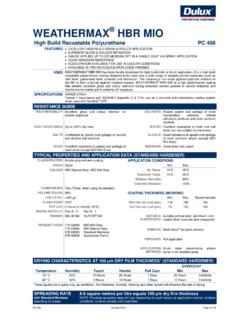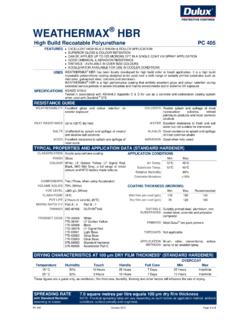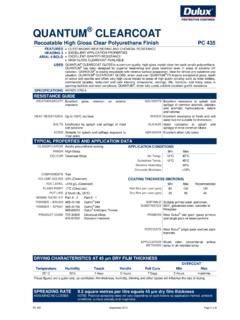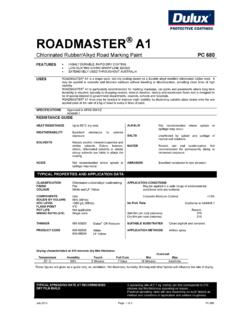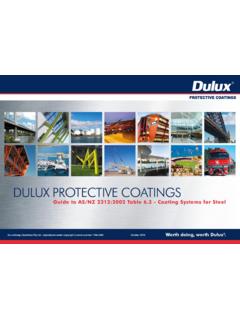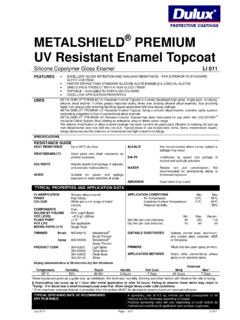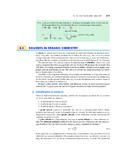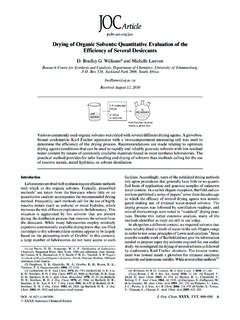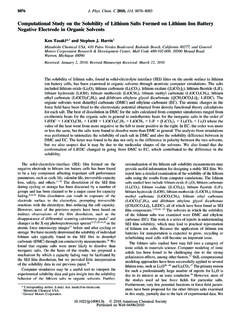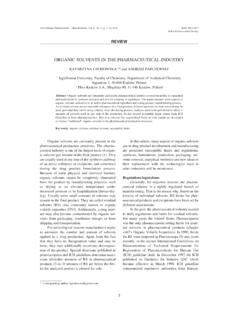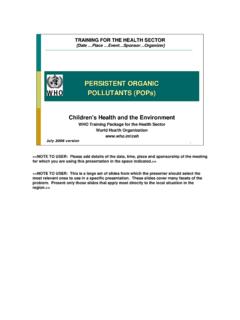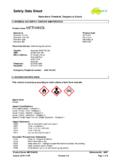Transcription of SAFE USE OF SOLVENTS - Dulux Protective …
1 safe USE OF SOLVENTS WHAT IS A SOLVENT? Generally speaking, SOLVENTS are liquids that are used to dissolve other components. In the paint industry, SOLVENTS are liquids or mixtures of liquids that dissolve resin and carry pigments and other paint components. In the case of water borne paints, the solvent is water, but the resin (or latex) is emulsified in the water, not dissolved in it. Small amounts of other SOLVENTS are also added to water based paints. There are three major uses of solvent in the paint industry: As a cleaning agent, to remove oily deposits from a substrate in preparation for painting, and to clean up equipment, paint splatter and spillages after paint application.
2 Dulux does not recommend that SOLVENTS are used for any more than removing waxy marking crayons or dye penetrant residues from the substrate, as the use of SOLVENTS to remove hydrocarbon (oil & grease) deposits can result in the solvent dissolving the grease and oil and then spreading it in an invisible film over the surface to be painted. As an integral part of a paint formulation As a paint thinner, to be post-added to paint to adjust application properties Common SOLVENTS used in paint include, but are not limited to: water, methyl ethyl ketone (MEK), turpentine (white spirit), methylated spirits (mixture of methanol and ethanol), xylene, toluene and acetone.
3 With the exception of water, SOLVENTS are organic (that is, they are carbon-based; derived from petrochemicals or plants). Whilst water is a common solvent, the word solvent in this Tech Note will refer to organic solvent. WHY ADD SOLVENT? The purpose of solvent in a paint formulation is to carry the paint from the container to the substrate in a form that allows the paint to be sprayed, brushed or rolled uniformly, and to assist in achieving the gloss level and dry film thickness required to offer the performance properties as stated on the product data sheet.
4 SOLVENTS can be chosen to improve the balance between application properties of paint, such as Viscosity Flow out Dry time Spreading rate Wet edge For example, fast dry time is desirable when spraying to reduce turn-around time, but can be a hindrance when brushing or rolling due to reduced wet edge and the appearance of excessive brush-marks and picture-framing (the appearance of a visible ridge around the perimeter of a wall where the brushed-in sections overlap the roller-applied sections).
5 SOLVENTS have a wide range of uses around the home and in industry, but must be used sparingly and with caution. Without a solvent that extends drying time, paint dries too quickly during application, and becomes too thick and stringy to allow a good finish. WHAT ARE THE HAZARDS? SAFETY Virtually all SOLVENTS are flammable, and even their vapours can ignite. Therefore, SOLVENTS should never be used anywhere near flames, such as gas pilot lights or lit cigarettes or sparks. HEALTH Breathing in solvent vapours can present short-term health problems, such as: Nausea Sore Eyes Headaches Dizziness These hazards disappear when the solvent vapour source is removed or the applicator dons breathing apparatus.
6 Long-term health hazards are accumulative effects on body organs such as kidneys, brain, liver and heart. There are clear exposure limits for each solvent. This exposure limit is clearly indicated on the MSDS. ARE PAINT SOLVENT VAPOURS HAZARDOUS? No more hazardous than the SOLVENTS present in many other household products, such as nail polishes, nail polish removers, cleaning agents (including natural products such as citrus oil-based cleaners), some furniture polishes and glues. All must be used sparingly and safely.
7 HOW DO I USE SOLVENT BASED PRODUCTS SAFELY? Do not rely on your sense of smell to warn you of solvent vapour hazards as not all SOLVENTS have a strong odour. Furthermore, the applicator can quickly become accustomed to many solvent odours and thus be totally unaware of their presence. With brush and roller application, the hazards are largely limited to splash and spillage of paint directly onto unprotected areas of the body, and inhalation of solvent vapours. Health risks associated with inhalation of solvent vapour can be avoided by the use of appropriate facemasks, either solvent masks or positive-pressure air-fed facemasks or hoods.
8 Protective clothing includes but not limited to: overalls, long sleeves, solvent-resistant gloves and regulation safety shoes) and a vapour mask. If application is by spray gun, however, inhalation of atomised paint (spray mist) is a greater health risk than that of inhaling solvent vapours and must be avoided. The airborne paint particles carry a mix of solids and liquids, including resins, pigments, hardener and solvent, and are more hazardous to inhale than solvent vapour.
9 Whenever spraying paint, avoid inhalation of atomised paint by the use of a well-fitting, positive-pressure, air-fed full-face respirator, and wear overalls, safety shoes and solvent-resistant gloves. Ensure you comply with all relevant provisions of your State Spray Painting Regulations (Qld, NSW, ACT, Vic, Tas, SA, WA & NT). For more information, please contact the Dulux Protective Coatings Technical Consultant in your state. Do not smoke or allow flames or sparks anywhere near containers bearing this sign In spray shops, correct personal protection equipment keeps the applicator safe from inhalation of spray mist and solvent vapour These applicators safely coated the Warragamba pipeline with Dulux Protective Coatings Even if spraying out in the open in extremely well ventilated environments, it still makes sense to protect yourself!
10
